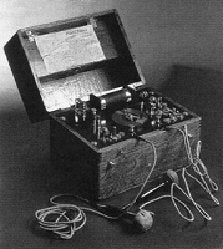How Not To Die by Electricity


(this is what the box looked like)
We all held hands. There were 5 of us.
Myself (8years old), my brother (11), my brother's friend also (11) and our neighbor (14).
The neighbor brought over a box his 90 year old grandfather said was used for treatment of arthritis. It was probably from the 1930s and most likely illegal in 1985.
The box was like an ancient voltage regulator: it had heavy metal rods - one for each hand. A wire extended from the box to each rod. Holding the rods in each hand would complete a circuit, sending electricity through your body in what felt like vibration - essentially it was a controlled electrocution. There was a metal slider. Pulling the slider out increased the voltage, and thus the vibration.
It was a scary device. And as kids that made us want to play with it a lot.
I dropped the handles when the slider hit 4, my brother and our neighbor could hold on until about 6.
And if you held hands you would all feel the shock coursing through you (person 1 held one rod, person 5 held the other rod, completing the circuit).
We could get up to about level 8, sometimes 9 if we were cruel and didn't let go of someone's hand but we never got to 10. We played with it probably 15 times before it went back into a dark, dingy basement and never seen again.
I'm sure you're asking yourself "where were their parents?"
Well, it was definitely irresponsible, but it was the 1980's and people were distracted by 1980s things like Ronald Reagan and A Ha so a lot of dumb things happened.
Today over 2.5M people are electrocuted in uncontrolled mains electric shocks every year.
Mains electricity is the common electricity found in homes - the alternating current (AC) powering everything we use.
Reasons for shock vary, but a big reason is unprotected electric outlets like the kind you have in your wall.
If you have kids, you should be very aware of a mains shock caused by insertion of a toy, paperclip, etc into an unprotected outlet. This is a top concern of parents everywhere.
Even extension cords and surge protectors have open and unprotected outlets.
You can buy outlet covers (cheap plastic tabs you stick into outlets when not in use) but they are hideous, a hassle when you pull them out to insert a plug every time, and they get lost. There today, gone tomorrow, exposing bare electric outlets. Furthermore, if you have kids you know they are not kid proof.
Tamper Resistant (TR) outlets are proven to be safer. The tamper gates inside the outlet permanently cover the electric terminals so cannot be dislodged easily by kids. But even if a home has TR outlets in the wall, as soon as you plug in an extension cord the unprotected outlets at the ends of the cords reintroduce the risk of shock.
Conway Electric uses Tamper Resistant (TR) outlets in every Extō because extending electricity should be done as safely as possible. And the only reason standard extension cords don't have safety features such as TR outlets is because it costs more and isn't easily manufactured into the plug.
Along with a product built for a lifetime, isn't it worth paying more to reduce the risk of shock? We think so.
Here are some more things you can do in your home to reduce the risk of shock:
1. If you don't have TR outlets, you can have an electrician switch to TR outlets or insert safety tabs into non-TR outlets (when leaving extension or power strips pluggged in, place tabs in all exposed outlets)
2. Make sure you have GFCI (ground fault circuit interrupter) outlets in your kitchen, bathrooms and anywhere you use electricity a lot (basements, especially shops, too) - GFCI outlets sense a change in flow of current and shut off - meaning it helps protect you from electrocution. GFCI outlets have the little red "reset" button (talk to an electrician to have these installed)
3. Avoid cube taps - those multi-outlet cubes that you insert into a wall to increase the number of plugs drawing power out. Think about the scene in "A Christmas Story" where 100 plugs are tapped into a single outlet: void this.
4. Replace missing or broken outlet covers so wires aren't exposed
5. Don't use any cords with exposed wires. If the jacket (outer covering) or wire of a cord gets cut, replace the cord immediately
6. Match light bulbs to the wattage specified on the bulb socket
7. Keep electricity away from water - including sinks, bathtubs, washing machines, etc
8. If an appliance trips a fuse frequently, have it checked. It could be faulty and require service
9. Keep small objects (especially metal) away from kids
10. Educate your kids about the dangers of electricity in and out of the home. Electric outlets and mains shocks are dangerous but playing near industrial power sources or downed power lines is extremely dangerous
And don't stop there. Talk to your electrician next time he comes by to learn more about your home electrical system.
Electricity is awesome and more necessary every day so a little care can go a long way. Let us know what you do to keep your kids safe and how you handle those unprotected extension cords.
Leave a comment
Comments will be approved before showing up.



